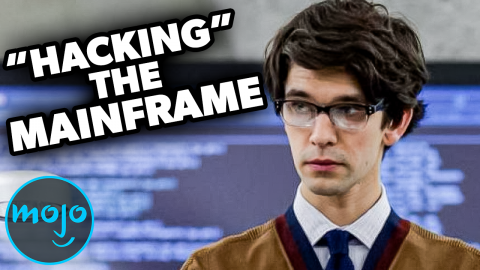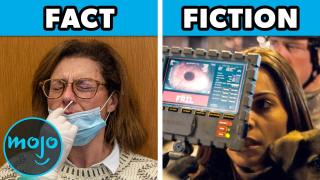Top 10 Things Movies Always Get Wrong

#10: Gun Silencers
Top 10 Things Movies Get Wrong About Dating
Do you have any idea how loud a gun can be when fired? Depending on the size of the weapon, it can exceed 160 decibels. So, despite what every murder mystery and buddy-cop flick might tell you, a silencer is not going to make it sound like a quick “poof” of air. While a suppressor can reduce the muzzle blast, it doesn’t silence it. There’s also still mechanical noise from the gun itself, and the sonic boom created by the bullet. And no, a pillow is not going to mask the sound coming out of a gun either.
#9: Parking in a Big City
Watch any TV show or movie, and you’re guaranteed to see someone park their car in a spot right in front of the building. If you’ve ever lived in a place like New York, you know you’re more likely to win the lottery than have this happen. It may be fairly common to see it on screen, but in the real world, you’re more likely stuck parking two or three blocks away and having to walk to wherever you’re going. We’ll suspend our disbelief for the entertainment factor, but we know this rarely happens in the real world.
#8: Holding Breath Underwater
The current Guinness World Record for holding your breath underwater is just shy of 25 minutes. But don’t let that record or Hollywood films fool you. Unlike what we see on the big screen, the average person can’t hold their breath underwater for more than a minute or so. Yet somehow, we consistently see action heroes and countless others seemingly holding their breath forever, even while being shot at. Only experienced freedivers who have trained for years can hold their breath for long periods of time. It requires specific techniques, such as hyperventilating, and training your body how to handle the CO2 you produce while holding your breath.
#7: Screeching Tires
If Hollywood were to be believed, every car, truck, or van on the planet would screech its tires when you hit the gas. It’s a common trope seen in countless movies and TV shows, but bears little resemblance to the real world. Yes, tires can make that awful noise, but that requires a lot of friction, and just isn’t the case for regular driving. Action sequences involving vehicles in film are often filled with tension, so the addition of a little squealing adds a sense of urgency to a scene. But for the real world, you’re only likely to hear it on a very hard break, or maybe a street race.
#6: Corsets
Watch any period piece that shows women getting dressed, and odds are you’ll see them in a corset. Often, corsets are depicted as being incredibly tight, even painful. In reality, a corset was worn over a chemise, rather than against bare skin, and designed to provide support, as well as for waist reduction. Men also wore them, although it was less common. Sure, they were laced around the body to form a particular shape, but as long as the fit of the garment was correct, the person wearing it would not experience the immobility and discomfort often shown on screen.
#5: Climbing Through Air Ducts
John McClane may have snuck through Nakatomi Plaza by squeezing into an air duct, but the chances of making a clean getaway are far less likely. Since the ductwork is only ever meant to carry air, it’s unlikely that the thin sheet metal would support the weight of the average-sized adult. Plus, let’s not forget the fact that often, those ducts are far too small to fit anyone other than a child. You may want to leave them for what they were designed for.
#4: CPR
Top 10 Things Movies Get Factually Right and Wrong About Pandemics
Cardiopulmonary resuscitation, or CPR as it’s commonly known, is a life-saving medical procedure that can be performed by most individuals. A series of chest compressions are used to help restore blood flow until the patient can be treated properly. Unfortunately, Hollywood often gets the use of CPR wrong. Arm and hand positions are often completely inaccurate when depicted on film. And unlike the real world, patients don’t miraculously revive and continue on their merry way after receiving such treatment. If you’re going to learn how to help someone who’s had a heart attack, you may want to take a course on CPR versus watching it in a movie.
#3: Explosive Shockwaves
Top 5 Explosive Facts About Super Weapons
If there’s anything the “MythBusters” have taught us, it’s that explosions cause serious damage, even from far away. How many times have you seen action heroes being blown clear of an explosion … only to stand up and walk away from it? As much as we want to think of the hero as being invulnerable, any blast hard enough to blow you clear would either kill you outright or seriously injure you. The shockwave that follows an explosion can often be more dangerous than the explosion itself. Combine the concussive force with that of shrapnel flying toward you, and you’re not going to just get up and walk away.
#2: A Woman’s Water Breaking
Things The Woman King Got Factually Right & Wrong
In virtually any fictional story told about a woman giving birth, there’s mention of her “water breaking.” This typically precedes the delivery of a newborn baby and is completely normal. However, when shown on film, the “breaking” of the water usually translates into the baby being born within minutes. Although it does happen, it’s far more likely that a woman will have a considerable amount of time before her child will be born. Every pregnancy is different, but the contractions that trigger the actual childbirth can begin as late as 24 hours after the water breaks. It’s very unlikely the baby will pop out within minutes of the big splash.
#1: Hacking
If there’s one thing Hollywood rarely ever gets right, it’s computer hacking. From “Hackers” to “The Net,” the process of breaking into another computer is never as glamorous or cool-looking as it is in the movies. There are no fancy holograms or visuals that hackers dig through. In fact, it’s more just screen after screen of text, and typing more than anything else. Given how vanilla hacking in real life looks, it’s no surprise that filmmakers embellish the look for entertainment purposes. Yet like all things, they do occasionally get it right, like in parts of “WarGames” and “The Matrix Reloaded.”





